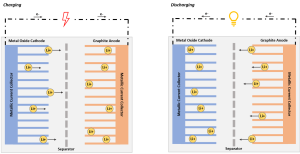Difference between revisions of "Lithium Ion Batteries"
Jump to navigation
Jump to search
| Line 4: | Line 4: | ||
{{#set: | {{#set: | ||
Has How it Works Description=Shuttle lithium ions (Li+) between cathode (+) and anode (-). Fully charged when | Has How it Works Description=Shuttle lithium ions (Li+) between cathode (+) and anode (-). Fully charged when Lithium ions are fully intercalated in the anode. | ||
|Has Varieties= | |Has Varieties= | ||
Lithium Iron Phosphate (LFP), | Lithium Iron Phosphate (LFP), | ||
| Line 13: | Line 13: | ||
Lithium Titanate Oxide (LTO) | Lithium Titanate Oxide (LTO) | ||
|Has Efficiency Range=80- | |Has Efficiency Range=80-92% | ||
|Has Cycle Life=3,000-10,000 cycles | |Has Cycle Life=3,000 - 10,000 cycles | ||
|Has | 10 - 20 years | ||
|Has Benefits=* | |Has Technology readiness level=9 - Deployed | ||
|Has Challenges=*Cycle life | |Has Benefits=* High power and energy density | ||
*Safety concerns | * Low self-discharge rate | ||
|Has Application= | * High roundtrip efficiency | ||
* Flexible configurations | |||
* Leverage cost reductions from consumer electronics and electric vehicle markets | |||
|Has Challenges=* Cycle life limitations, especially with high depth of discharge | |||
* Safety concerns around fire and explosion risk | |||
* Supply chain constraints | |||
|Has Application=Diverse applications from minutes to hours duration and from small scale residential to transmission connected. | |||
|Has image=File:LithiumIonImage.PNG | |Has image=File:LithiumIonImage.PNG | ||
|Has Installed Capacity=>10 GW | |||
}} | }} | ||
Revision as of 09:10, 23 December 2021
